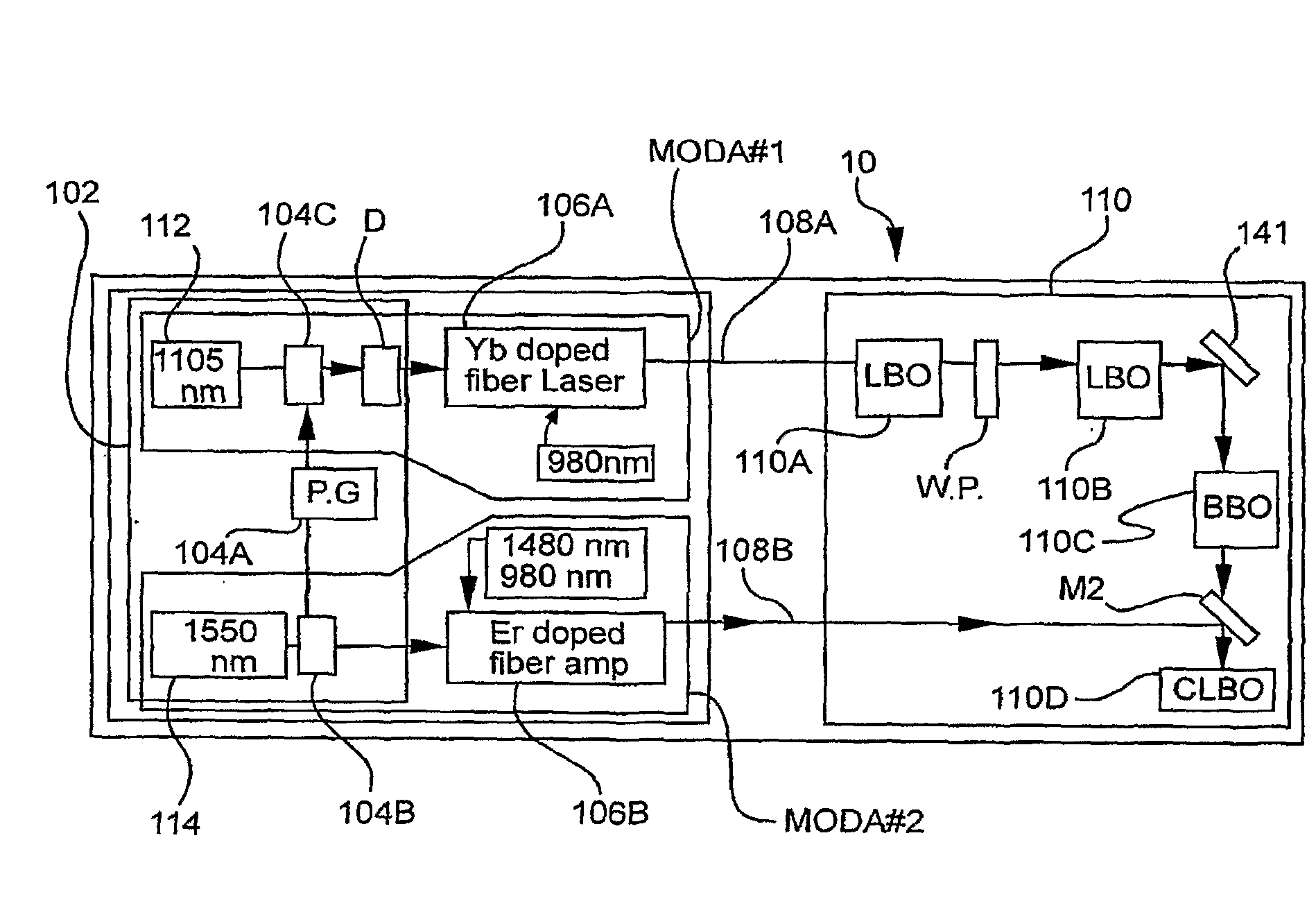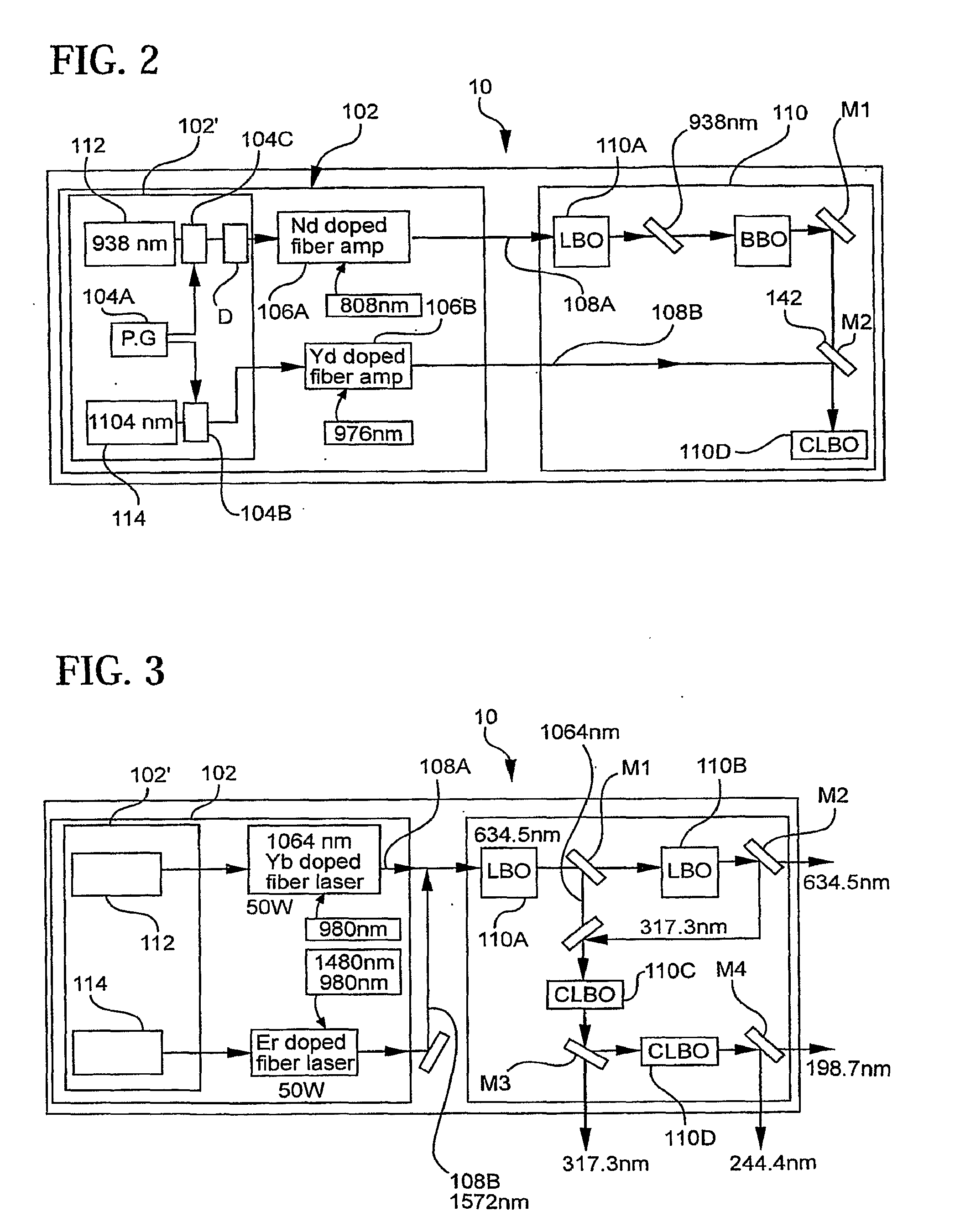UV and Visible Laser Systems
a laser system and visible light technology, applied in the field of solid-state lasers, can solve the problems of poor beam quality, high cost of lasers, and limited choice of shorter wavelength light sources (e.g., visible or uv), and achieve the effect of higher optical frequency
- Summary
- Abstract
- Description
- Claims
- Application Information
AI Technical Summary
Benefits of technology
Problems solved by technology
Method used
Image
Examples
example 1
Laser system I for Producing an Output at λ=193.0 nm
[0031]Sub-200 nm laser light sources are very important for metrology applications in the semi-conductor industry. As the feature sizes of integrated circuits are shrinking, shorter wave-length light is used for a photolithography. Mask and wafer inspection, as well as optics manufacturing is then in need of the same or similar DUV light wavelength. The systems presently used, based on solid-state laser sources, harmonic conversion and OPOs, typically work at very low repetition rates, are very bulky, complex, expensive and require frequent and complicated maintenance.
[0032]FIG. 1 illustrates schematically the first exemplary embodiment of the 193.0 nm laser system 10. As described above, the optical system 10, according to this embodiment, includes two optical fiber amplifiers 106A, 106B that provide synchronized pulse outputs of different wavelengths to the frequency converter 110. In this exemplary embodiment, the Yb-doped fiber...
example 2
Laser System for Producing an Output at λ=193.4
[0037]FIG. 2 presents an example of a 193.0 nm laser system 10 according to another embodiment of the present invention. The laser system 10 of this embodiment is similar to that of the embodiment of example 1 in that it includes a pulsed light source 102 comprising two seeded high power optical amplifiers 106A, 106B that (in parallel) provide synchronized first pulsed light 108A, 108B to the frequency converter 110. However, in this embodiment the first amplifier 106A is Nd-doped (SiO2 based) fiber amplifier. More specifically, the 935.6 nm output of Nd-doped amplifier 106A is provided to the first stage 110A. (LBO crystal) of the frequency converter 110. The 1104 nm output of Yb-doped fiber amplifier 106B is simultaneously provided to the CLBO crystal (3rd stage 110C of the frequency converter 110). The frequency converter 110 includes one LBO crystal 110A, one BBO crystal 110B and one CLBO crystal 110C. The three nonlinear crystals, ...
example 3
Laser System for Producing an Output at λ=198.7 nm
[0043]FIG. 3 illustrates schematically the exemplary embodiment of the 198.7 nm laser system 10. As described above, the optical system 10 according to this embodiment, includes two seeded optical fiber amplifiers 106A, 106B that provide synchronized pulsed outputs of different wavelengths to the frequency converter 110. In this exemplary embodiment, the 1064 nm seeded Yb-doped fiber amplifier 106A of the light source 102, produces a narrow linewidth output at the wavelength λ1Aout=1064 nm. Seeded Er-doped fiber amplifier 106B simultaneously produces light 108B at a narrow linewidth output at wavelength λ2Aout=1572 nm. The 1164 nm and 1572 nm light from the amplifiers 106A, 106B is then provided to the first stage of the frequency converter 110. In this embodiment, the frequency converter 110 includes two LBO crystals 111A, 110B, and two CLBO crystals 110C, 110D. The first stage of the frequency converter 110 corresponds to the LBO c...
PUM
 Login to View More
Login to View More Abstract
Description
Claims
Application Information
 Login to View More
Login to View More - R&D
- Intellectual Property
- Life Sciences
- Materials
- Tech Scout
- Unparalleled Data Quality
- Higher Quality Content
- 60% Fewer Hallucinations
Browse by: Latest US Patents, China's latest patents, Technical Efficacy Thesaurus, Application Domain, Technology Topic, Popular Technical Reports.
© 2025 PatSnap. All rights reserved.Legal|Privacy policy|Modern Slavery Act Transparency Statement|Sitemap|About US| Contact US: help@patsnap.com



